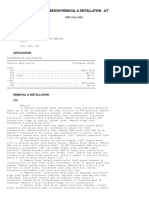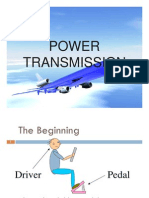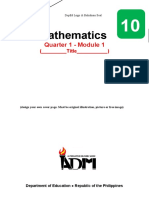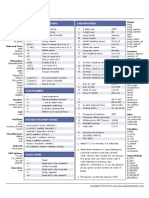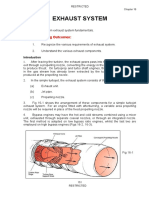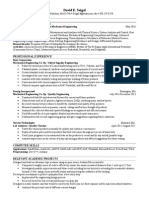Leaf Spring
Leaf Spring
Uploaded by
Thayumanavan KSCopyright:
Available Formats
Leaf Spring
Leaf Spring
Uploaded by
Thayumanavan KSCopyright
Available Formats
Share this document
Did you find this document useful?
Is this content inappropriate?
Copyright:
Available Formats
Leaf Spring
Leaf Spring
Uploaded by
Thayumanavan KSCopyright:
Available Formats
y A leaf spring is a simple type of suspension spring
commonly used in heavy duty vehicles.
y The advantages of leaf spring over helical spring is that
the ends of the spring be guided along a definite path as it deflects to act as a structural member in addition to energy absorbing device.
y Double eye y Slipper-open eye end y Slipper-hook end y Slipper-flat end y Slipper-radius end
y Leaf springs used in automobiles is of Semi-Elliptical y y y y y
in form. It is built up of number of plates(known as leaf) , which are of reducing lengths. The longest leaf is called main leaf or Master leaf, And the other leaves are called as graduated leaves. The spring is clamped to the axle by means of U-bolts. Rebound clips are used to hold the leaves together. Central clamp is used to fix the position of leaf spring to the wheel axle.
The different types of manufacturing process involved are: y Shearing of flat bar y Center punching y End Heating process forming (hot & cold process) y Heat treatment y Surface preparation y Eye bush preparation process y Assembly
y Width (mm) : 25-80 mm in steps of 5mm
y Thickness (mm) : 2-8 mm in steps of 1mm, 10-16
mm in steps of 2mm
y The materials used for leaf springs is usually a plain
carbon steel having 0.90 to 1.0% carbon. y According to Indian Standards the Recommended Materials are: y For Automobiles : 50 Cr 1 , 50 Cr 1 V 23 , 55 Si 2 Mn 90 , used in Hardened and Tempered state. y For Rail Road Springs : C 55(water-Hardened , C 75-Oil hardened) , 40 SI 2 Mn 90 (Water Hardened) and 55 Si 2 Mn 90 (Oil hardened)
y Bending Stress in each plate of the leaf spring: y B= 6WL/(nbt 2) y Deflection of the plate: y
=4WL 3/(nEbt 3)
Now-a-days industries are trying to reduce the weight and increase the strength of leaf spring for efficient suspension. ARC Composite carbon fiber is the best material suitable for the above required criteria. This material has less weight and high strength when compared to the materials using in the leaf springs using in nowadays leaf springs.
1) Specifically made to give effects like Air Suspension with out any extra external energy(Fuel) 2) No permanent deformation hence no re-cambering, thus no maintenance. 3) Minimum wear and tear of body parts and tyre due to delicate tendency of absorbing road shocks, jerks and vibrations. 4) Softer ride, Lower noise level, excellent stability due to better damping characteristics. 5) Excellent corrosion resistance against atmospheric pollutants. 6) Five times stronger than conventional metal leaf springs.
7) Fully interchangeable with the conventional spring without any modifications. 8)Increase in fuel efficiency due to better aerodynamics and around 60% weight reduction. 9) No cracking sound since mono leaf and hence no inter-leaf friction and no greasing required. 10) Fatigue life 1 million cycles as compared to only 2 lacks for the metal leaf springs.
You might also like
- FLRegkey RegDocument4 pagesFLRegkey RegAlbert Mejia28% (46)
- Lecture On: Clutch and Gear Box Prepared byDocument18 pagesLecture On: Clutch and Gear Box Prepared byParth ParikhNo ratings yet
- Leaf SpringDocument52 pagesLeaf Springrachit chourasiaNo ratings yet
- The Gear BoxDocument21 pagesThe Gear BoxRuwan ChandraNo ratings yet
- Topic: Suspension System: Group 1 MembersDocument21 pagesTopic: Suspension System: Group 1 MembersMilcentNo ratings yet
- AxleDocument10 pagesAxleAshish Tak0% (1)
- Transmission Removal and Installation at PDFDocument4 pagesTransmission Removal and Installation at PDFOskars ŠtālsNo ratings yet
- Atos Solenoid Valve BrochureDocument3 pagesAtos Solenoid Valve BrochurefresitoNo ratings yet
- 6 Front Axle - FA90Document21 pages6 Front Axle - FA90PRASUN NATHNo ratings yet
- Classifications of CouplingsDocument20 pagesClassifications of Couplingssyampnaidu100% (3)
- Drive ShaftDocument16 pagesDrive ShaftDustin MartinNo ratings yet
- Differential Functions Parts Woking Advantages Disadvantages and Applications PDFDocument6 pagesDifferential Functions Parts Woking Advantages Disadvantages and Applications PDFRohan ModhNo ratings yet
- ClutchDocument37 pagesClutchMohan PreethNo ratings yet
- Wheel Balancing Machine PDFDocument26 pagesWheel Balancing Machine PDFSrinivas100% (1)
- Stall Test Procedure - Vehicle Technology - Beyond DiscoveryDocument8 pagesStall Test Procedure - Vehicle Technology - Beyond DiscoveryArtyom FreemanNo ratings yet
- Tapers and Taper TurningDocument4 pagesTapers and Taper TurningSayanSanyal100% (1)
- Table of ContentDocument19 pagesTable of ContentAmrit singhNo ratings yet
- Three Axis Pneumatic Modern TrailerDocument26 pagesThree Axis Pneumatic Modern Trailerjaiy12No ratings yet
- Leaf SpringDocument34 pagesLeaf SpringjonNo ratings yet
- Presentation ON: CouplingDocument32 pagesPresentation ON: CouplingJonnalyn ArcinasNo ratings yet
- Crown Wheel and Pinion GearDocument2 pagesCrown Wheel and Pinion Geargksamy0% (1)
- Unit 6 Clutches, BrakesDocument61 pagesUnit 6 Clutches, BrakesSumit KumarNo ratings yet
- Design MethodologyDocument7 pagesDesign MethodologyRaviJoshiNo ratings yet
- 4.1 Steering Geometry and Types of Steering Gear Box-Power SteeringDocument19 pages4.1 Steering Geometry and Types of Steering Gear Box-Power SteeringDEEPAK S SEC 2020No ratings yet
- Gears Design MD2Document52 pagesGears Design MD2Faizan MohyuddinNo ratings yet
- Automotive Transmission SystemDocument94 pagesAutomotive Transmission SystemTanzim Rafat AyonNo ratings yet
- A Notes On Coupling: Basic Function of CouplingDocument12 pagesA Notes On Coupling: Basic Function of Couplingnavin srivastavaNo ratings yet
- CH 5 Arresting Gear & BrakesDocument47 pagesCH 5 Arresting Gear & BrakesEbrahim Ali100% (1)
- Chapter 10 (Standard Transmission) PDFDocument42 pagesChapter 10 (Standard Transmission) PDFZIBA KHADIBINo ratings yet
- Design of Keys and CouplingsDocument20 pagesDesign of Keys and CouplingsAliya A KhanNo ratings yet
- SUSPENSION System Notes FinalDocument23 pagesSUSPENSION System Notes FinalPAUL NDIRITU100% (1)
- A Study On Power Transmission System in Automotive Vehicle at Vehicle Care Pvt. LimitedDocument58 pagesA Study On Power Transmission System in Automotive Vehicle at Vehicle Care Pvt. LimitedDipayon SahaNo ratings yet
- Drive ShaftDocument8 pagesDrive ShaftAkshat SharmaNo ratings yet
- Main Shaft AssemblyDocument14 pagesMain Shaft AssemblyFrancis MartinezNo ratings yet
- Design of Spur GearsDocument29 pagesDesign of Spur GearsAishwarya Ramesh100% (1)
- Differential Unit: University Kuala Lumpur Malaysia France InstituteDocument24 pagesDifferential Unit: University Kuala Lumpur Malaysia France Instituteabhinav abburiNo ratings yet
- Chapter 3 Lathe MachineDocument28 pagesChapter 3 Lathe MachineMohd HapisNo ratings yet
- Power Transmission IOEDocument94 pagesPower Transmission IOEEr. Satya Narayan Shah100% (2)
- Track Chain Removal and AssemblyDocument12 pagesTrack Chain Removal and AssemblyAaron MulengaNo ratings yet
- Flywheel 08818Document32 pagesFlywheel 08818Dawit BehailuNo ratings yet
- Presentation On Design of Transmission System For A GokartDocument21 pagesPresentation On Design of Transmission System For A GokartNikhil WarungaseNo ratings yet
- See Figures 1 Thru 7: Suspension SystemDocument28 pagesSee Figures 1 Thru 7: Suspension SystembalajigandhirajanNo ratings yet
- Chapter 14 (Automatic Transmission Maintenance)Document19 pagesChapter 14 (Automatic Transmission Maintenance)ZIBA KHADIBINo ratings yet
- Bendix® AD-IS® EverFlow™ AssemblyDocument10 pagesBendix® AD-IS® EverFlow™ Assemblyjgomez30No ratings yet
- Types of Axles Front Axle Rear Axle and Stub Axle PDFDocument7 pagesTypes of Axles Front Axle Rear Axle and Stub Axle PDFraghav100% (1)
- Service Schedule FordDocument2 pagesService Schedule FordsmokefieldNo ratings yet
- Gear Box PDFDocument10 pagesGear Box PDFRoshan KumarNo ratings yet
- 57 Automotive Steering System Service RevisedDocument57 pages57 Automotive Steering System Service Reviseddmc constructionNo ratings yet
- 15ae302 - Driveline and Final DriveDocument35 pages15ae302 - Driveline and Final DriveAahana KhannaNo ratings yet
- How To Determine Gear RatioDocument10 pagesHow To Determine Gear RatiopanjiNo ratings yet
- Mobile Hydraulic Tips: Component Basics For Mobile Equipment HydraulicsDocument16 pagesMobile Hydraulic Tips: Component Basics For Mobile Equipment HydraulicsSamik Mukherjee100% (1)
- Mechanical Engineering Department: Lab ReportDocument17 pagesMechanical Engineering Department: Lab ReportLukman Hadi0% (2)
- Front Wheel DriveDocument24 pagesFront Wheel DriveHamnuren ManabilangNo ratings yet
- V2 3 6 Final Gear and Differential GearDocument44 pagesV2 3 6 Final Gear and Differential GearDwy Bagus N100% (1)
- ClutchesDocument17 pagesClutchesRanjit RajendranNo ratings yet
- Multistage and Poly Stage ConverterDocument22 pagesMultistage and Poly Stage ConverterkirthikNo ratings yet
- Planetary Gear Unit-PPT 3Document24 pagesPlanetary Gear Unit-PPT 3Gemechu DemeNo ratings yet
- CHAPTER 3 - Keys and PinsDocument30 pagesCHAPTER 3 - Keys and PinsNabil FikriNo ratings yet
- Slidingmesh GearboxDocument27 pagesSlidingmesh GearboxalebiegashityNo ratings yet
- Shaft Couplings: Types, Working, Diagram, Advantages and ApplicationsDocument20 pagesShaft Couplings: Types, Working, Diagram, Advantages and Applicationsvj kumarNo ratings yet
- Prepared By: Saurabh Modi Asst. Professor Parul Institute of Technology Parul UniversityDocument15 pagesPrepared By: Saurabh Modi Asst. Professor Parul Institute of Technology Parul UniversityYash DharaniNo ratings yet
- Naive Bayes ClassificationDocument10 pagesNaive Bayes ClassificationPooja Racha100% (2)
- Centre For Educational Research and Innovation BrochureDocument17 pagesCentre For Educational Research and Innovation Brochurezecag3n0c1d4No ratings yet
- CRN7921954130Document3 pagesCRN7921954130Himanshu MishraNo ratings yet
- Physical Chemistry - Energetics - Problems From Ex. - Heat Energy - Page 225 Student BKDocument5 pagesPhysical Chemistry - Energetics - Problems From Ex. - Heat Energy - Page 225 Student BKMin Khant ZawNo ratings yet
- Mathematics: Quarter 1 - Module 1Document27 pagesMathematics: Quarter 1 - Module 1Lodivico MolinaNo ratings yet
- Feminist Literary CriticismDocument15 pagesFeminist Literary Criticismgoose50850No ratings yet
- Revision Booklet SOLUTIONDocument11 pagesRevision Booklet SOLUTIONFatima Al NeyadiNo ratings yet
- PHP Cheat SheetDocument1 pagePHP Cheat Sheetanon-280494100% (4)
- Translational Mechanical System Transfer FunctionsDocument30 pagesTranslational Mechanical System Transfer FunctionsRhizhailNo ratings yet
- pl888226 Tod Inventory CutoffDocument21 pagespl888226 Tod Inventory Cutoffeltoquek0No ratings yet
- 22 Azka Faranisa AnandaDocument10 pages22 Azka Faranisa AnandaMinh Anh Lê TrầnNo ratings yet
- Tab IndexDocument21 pagesTab IndexAhmad ElsheemyNo ratings yet
- Appi Psychotherapy 20220018Document8 pagesAppi Psychotherapy 20220018consulta.nicolaslabbeNo ratings yet
- MS Word Groups and CommandsDocument69 pagesMS Word Groups and CommandsMr. No Jow100% (1)
- Week 3 Tema 41 Octubre 2020Document12 pagesWeek 3 Tema 41 Octubre 2020ismael palmaNo ratings yet
- Cert ABB Reuse 090410 P0005 C002 V1R1Document2 pagesCert ABB Reuse 090410 P0005 C002 V1R1AkoKhalediNo ratings yet
- Types of Rear AxleDocument3 pagesTypes of Rear AxleShashank Chheniya100% (4)
- UIT2305U1LS04Document16 pagesUIT2305U1LS04mohit.official04091kNo ratings yet
- Preventive Maintenance FormDocument1 pagePreventive Maintenance FormEko Suwondo0% (1)
- Fluid Mechanics FormulasDocument1 pageFluid Mechanics FormulaskennethNo ratings yet
- Exhaust System: Objective: Desired Learning OutcomesDocument8 pagesExhaust System: Objective: Desired Learning OutcomesKhurram AliNo ratings yet
- David Seigal WeeblyDocument1 pageDavid Seigal Weeblyapi-279804454No ratings yet
- How To Make A CupDocument2 pagesHow To Make A CupjyNo ratings yet
- Alvin LeongDocument5 pagesAlvin LeongMacro YowNo ratings yet
- WDG 12 - Technical Data Sheet LV 804 TDocument8 pagesWDG 12 - Technical Data Sheet LV 804 T3efooNo ratings yet
- Nglish Hindi Words Devanagari ScriptDocument3 pagesNglish Hindi Words Devanagari ScriptameendaNo ratings yet
- 02 - Statistic With Computer Application - Sampling ProcedureDocument15 pages02 - Statistic With Computer Application - Sampling ProcedureAustin Capal Dela CruzNo ratings yet
- 7ML19985FB06 1Document284 pages7ML19985FB06 1chandraprakashhhNo ratings yet
- Vergunst - Bridge To Genesis Volume IIDocument91 pagesVergunst - Bridge To Genesis Volume IIdevararavibabu_92002No ratings yet






